
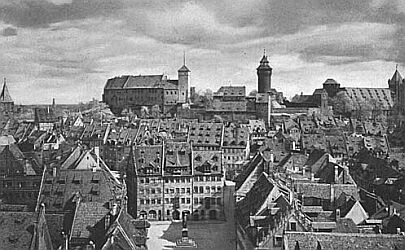 View of pre-war Nuremberg from from the St. Sebald church towards the Dürer-Monument and the Castle Nietzsche and Nuremberg As far as I know, Nietzsche has actually visited Nuremberg three times in his life, namely in 1861, 1867 and 1873. Therefore, it seems natural that I would want to document his stays in my native city and provide some explanatory illustrations.
A lithography by Rudolph and Julius Geißler (1861) vividly depicts this event at the Hauptmarkt, surrounded by St. Sebaldus church, the City Hall and the "Schöne Brunnen" (Beautiful Fountain)  The following picture bears witness to the fact that the restoration of these sites has been conducted in a suitable fashion. It depicts approximately the same view as the above lithography from 1861. 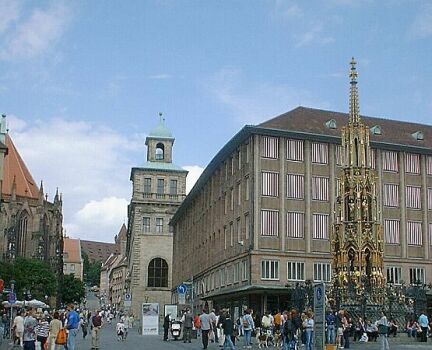 Photo HW 2001 (to the left the St. Sebaldus church, in the middle the so-called "Kaiserstallung" and "Luginsland", to the right the old City Hall by Wolf and the new City Hall, as well as the "Schöne Brunnen" Obviously, Nietzsche had arrived by train from Plauen, where he had stayed at his "dear aunts'" (and with his wealthy uncle Hermann Friedrich Theodor Nietzsche). On July 20, 1861, young Nietzsche received a traveling document that was issued by the Royal Court at Plauen and allowed him, the "Zögling der Fürstenschule Pforte bei Naumburg, Friedrich Wilhelm Nietzsche [...] zur Reise nach Nürnberg und die fränkische Schweiz, zum Vergnügen" ["the student of the Prince's School at Pforta near Naumburg, Friedrich Wilhelm Nietzsche [...] to travel to Nuremberg and to Swiss Frankonia for his vacation"]. With respect to his stay at Nuremberg, he made the following notes (Chronik p. 79): »Nachtreise. Hof. Ueberfüllung. Unordnung. Unwohl. Bamberg. Besser. Nürnberg. Reisegesellschaft. 2 Sänger 1 dicker Herr, ein stummer Stiller, die Dame mit naseblut[endem] Kind usw. Ungemüthlichkeit.– ["Nightly travel. Hof. Crowded. Messy. Not feeling well. Bamberg. Better. Nuremberg. Traveling companions: 2 singers, 1 fat gentleman, a silent man, a lady with a child with a bleeding nose, etc. Discomfort"]  The old Nuremberg railway station beyond the city walls - built in 1846, torn down in 1903 erster Eindruck der Stadt. Schmids. Höflichkeit der Nürnberger. Ausgehen. Allgemeine Bemerkungen. Festhalle. Probe. (unleserlich) Rückkehr. Aegidienkirche mit prachtvollen Nebenkapellen Dürerbilder Jesus auf Gethsemane. Frauenkirche, catholscher Gott[esdienst,] bunte Fenster. Buchhandlung v[on] Schmidt. Mittag, die vier Direktoren. Champagner. Konzert. Blaues Glöckli. lange gesucht. Kapellmeister Tschirch Komponiren. Oper: Meister Martin und seine Gesellen sucht in Nürnberg aufzuführen die Schwäne, Schwanengesang vollendet. componirt früh, arbeitet in der Nacht aus. – Nachtquartier.
Morgen. Stadtweg. Promenade Festhalle. Kaiserstüblein Rathhaus. Museum. Schmid Lorenzkirche. Mittag. Festzug. Konditorei. Hans Sachs, Dürer. Glöckel. Schmid. Abendbrod. Bier. Klavier gespielt. Hinweg. [unleserlich] Spinnerei. – Nachtblick. Morgen. Abschied vom Wirth. Gang um die Stadt. Junge. Herrn Bulls Freundlichkeit. Auf die Burg. Aussicht. Rathhaus. Gesellenstehen. – Schmid. Bahnhof. Ausschmückung. Rosenau. Durch die Stadt. 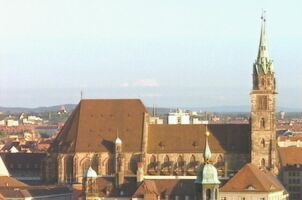 Lorenz church
Apparently, Nietzsche had a chance to meet some relatives in Nuremberg (and was even able to play the piano), namely with the family Schmid he referred to. Perhaps, this family is even related to Alfred Schmid at Plauen who was married to an aunt of Nietzsche, Hedwig Nietzsche (which made Alfred Schmid of Plauen a relative by affinity of young Nietzsche) who was also Nietzsche's god-uncle? In any event, he obviously attended the rehearsals, what he would also do later, during his Bonn study year, and he took in many of Nuremberg's sights, so that he, in addition to the mentioned Egidien-Church, the Frauenkirche and the St.-Lorenz-Church, must certainly also have seen the St. Sebaldus-Church, since he obviously had his supper and beer at the "Glöckel", as he also did during his second visit in the company of Rohde. This picturesque Bratwurst Inn named "Bratwurstglöckle" was built right next to the Moritz Chapel besides the St. Sebaldus Church.
Unfortunately, the City of Nuremberg does not see itself in a position to rebuild the chapel and the adjacent, traditional inn. Rather, it hoped that "future generations" will do so .. therefore, one of the most original sights in Nuremberg could not yet be re-built in its original form. With respect to this visit, I can add some material that I have found in the 'BAW' edition of Nietzsche's works, the 'Beck'sche Ausgabe Werke 1933-1940)': Only a year has passed in 1861 since Ludwig Feuerbach had to move to his Rechenberg residence in Nuremberg after the bankrupcty of his wife's porcelain manufacturing plant--which would mean that, in 1861, Nietzsche would have had a chance to meet this philosopher, whose works, 'Wesen des Christentums' and 'Gedanken über Tod und Unsterblichkeit' he had entered on his wish list for his birthday of this year (October 15, 1861) (BAW I, 251). Added on April 8, 2005: "/ Rechenberg bei Nürnberg, 31. Juli [1861] Hochgeehrter Herr, Erläuterungen in GW 20, 395: Sängerfest: Vom 20. bis zum 23. Juli 1861 fand in Nümberg das "Allgemeine Deutsche Sänger-Fest" statt. Vgl. Gesänge zum deutschen Sänger-Fest in Nürnberg vom 20. bis 23. Juli 1861 und Gedenkbuch des in der Stadt Nürnberg 1861 begangenen Großen Deutschen Sängerfestes. Auf Veranlassung des Festausschusses herausgegeben. Mit drei Stahlstichen, Nürnberg 1861. [Explanations in GW 20, 395: Sängerfest: From July 20th to 23rd, 1861, took place in Nürnberg as the "Allgemeine Deutsche Sänger-Fest". See also songs for the German Sänger-Fest in Nürnberg from July 20th to 23rd, 1861 and "Gedenkbuch" [Commemorative Publication] of the Great German Sängerfest (Festival of Singers] that took place in the city of Nürnberg in 1861. Published at the direction of the Festival Committee. With three steel etchings, Nürnberg, 1861.] BAW I, 254 --here Nietzsche made the following notes: "Museum 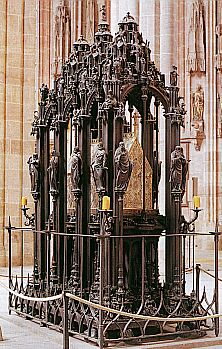 The tomb of St. Sebaldus at the Sebaldus-Church, by P. Vischer
BAW I, 255 here, he also noted:
"Hans Behaim, Nürnberg erhaben, Pirkheimer, nach Dürer. 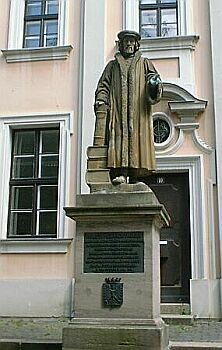 The Melanchthon-Staue vn fromt of the old Melanchthon-Gymnasium at the Egidienplatz Moreover, Nietzsche had also visited the so-called "Kaiserstübchen" (Imperial Room) in the late-Gothic Scheuerl house of 1486 in which German emperors used to stay frequently. (This property of an old Nuremberg patrician family at Burgstrass 10 was completely destroyed on January 2, 1945). With respect to these Imperial visits, Nietzsche wrote down the following poem:: "Es giengen hier in der Scheurlbergerhaus And in BAW I, 259, he surprisingly noted: "O Nürnberg, Nürnberg, heilge Stadt II. Tour witn Rohde in August, 1867 with stay in Nuremberg on August 19 and 20. Partly by train, partly on foot, these two friends traveled, among other places, to Eger, Altenburg, Cham, Zwiesel, Regensburg, Nuremberg, Coburg and Meiningen during this summer. While Rohde made extensive notes into his travel diary, Nietzsche, as in 1861, only made notes in point-form, and that also of details of his expenses (his mentioning of these expenses would suggest that he was on a tight budget): "Anreise von Regensburg mit der Bahn. Selbstverständlich werden im Glöckle die obligatorischen Bratwürste mit Sauerkraut verzehrt (18 Kreuzer), dann wird ein Bad genommen (8 Kreuzer), ansonsten läßt man es sich die nächsten zwei Tage mit Besichtigungen (Germanisches Museum, 30 Kreuzer) und vielfachem Einkehren (‚Kafé Nörrs – schlecht – Kaffe [9 Kreuzer]’) Konzert und Bier (10 Kreuzer) wohlergehen." (Chronik S. 170) Immediately after this journey, Nietzsche had to start his tour of duty with the artillery at Naumburg. In November, he reminisced mournfully: "Heute feiere ich den Sonntag auf meine Weise, indem ich mich meines fernen Freundes und unserer gemeinsamen Vergangenheit in Leipzig und im Böhmerwald und in Nirwana [Anspielung auf die Aufführung des gleichnamigen Werkes von H. v. Bülow im Schopenhauerschen Geiste, das in Meiningen aufgeführt worden war – "die Musik war fürchterlich"] gedenke. ... Damals ein Leben in freiester Selbstbestimmung, im epikuräischen Genuß der Wissenschaft und der Künste." (Briefwechsel mit Rohde, S. 11) III. Alone in Nuremberg at Easter, on April 13. and 14, 1873 In the spring of 1873, Overbeck and Nietzsche, while living at their common Basel apartment in the "Baumannshöhle", Schützengraben 45, wrote their respective works, namely Nietzsche his "Erste Unzeitgemäßße Betrachtung" on "David Friedrich Strauss, der Bekenner und Schriftsteller", and Overbeck his work, "Ueber die Christlichkeit unserer heutigen Theologie" which were published by Fritzsch in Leipzig, with the help of Richard Wagner. For their own use, they had these works bound together, and Nietzsche dedicated this single edition to Overbeck, with the following poemt: "Ein Zwillingspaar aus dem Einem Haus / ging muthig in die Welt hinaus, / Welt-Drachen zu zerreißen. / Zwei-Väterwerk! Ein Wunder war’s / Die Mutter doch des Zwillingspaars / Freundschaft ist sie geheissen!" (Briefwechsel mit Overbeck S. 8) At the end of the winter semester, Nietzsche and Rohde visited Richard and Cosima Wagner at Bayreuth from April 6 to April 12 (the Saturday before Easter Sunday), where they saw the new "Haus Wahnfried" that was still under construction. Nietzsche read from his manuscript, "Die Philosophie im tragischen Zeitalter der Griechen", "ich habe mich wieder auf das herrlichste überzeugt, was die Griechen sind und waren. Der Weg von Thales bis Sokrates ist etwas Ungeheures." (KSB, 4, Nr. 301, S. 139, "I was once again able to convince myself in a wonderful fashion what the ancient Greeks are and were. The path from Thales to Socrates is something incredible.) On Good Friday, Cosima wrote in her diary, "Uns verdrießt ein wenig die musizierende Spielerei unseres Freundes ..." ("we are not enjoying our friend's musik making") (this "enjoyment" would "increase" during the next year, as can be read in our Nietzsche-Wagner page); on April 12, Nietzsche left with his friend Rohde, "in a melancholy mood", and they part company at Lichtenfels. Read what Nietzsche wrote to his friend Rohde in his letter of May 5, 1873, from Basle (Briefwechsel mit Rohde p. 406 ff.): Theuerster Freund, bist Du wieder in der Semesterthätigkeit darin? Wir fangen so nachgerade in diesen Tagen an. Was Glänzendes wird es wieder nicht, doch auch nicht so lumpig und so durchaus verächtlich, wie im vorigen Winter. ... Overbeck ist mit seiner Schrift (wir nennen sie "Zukunftstheologie") fertig, auch der Verleger ist gefunden – und wer? Fritzschius! Natürlich in so schönem Gewande wie die Geburt der Tragödie auftretend, wird sie nicht verfehlen, alle theologischen Parteien zur Entrüstung zu bringen. Gersdorff hat Recht, wenn er schreibt, Basel sei vulcanisch geworden. Auch ich habe wieder etwas Lava gespien: eine Schrift gegen David Strauß ist ziemlich fertig, wenigstens in der ersten Skizze – aber ich bitte Dich um Grabes-Nacht-Stillschweigen, denn es wird eine große Mystifikation in Scene gesetzt. Ich kam von Bayreuth in einer solchen anhaltenden Melancholie zurück, daß ich mich endlich nirgends anderswohin retten konnte, als in die heilige Wuth. ... Weißt Du, daß unser überaus festlicher Abschiedstrunk in Lichtenfels mich berauscht gemacht hatte? Nämlich es trat das Phänomen ein, daß ich wähnte, ich würde in einem großen Rade mit herumgedreht: dabei wurde mir schwindlicht, ich schlief ein, wachte in Bamberg auf, trank Kaffee: und war Mensch wie zuvor. Verlebte dann den Nachmittag in Nürnberg, sowie den zweiten Ostertag, und befand mich körperlich ebenso wohl als höchst, höchst schwermüthig! Dabei waren alle Leute geputzt und liefen im Freien herum, und die Sonne so herbstlich mild. Nachts sauste ich nach Lindau ab, fuhr, im Kampf von Nacht- und Tagesgestirn, früh um fünf Uhr über den Bodensee, kam noch zeitig am Rheinfall bei Schaffhausen an, machte dort Mittag. Neue Schwermuth, dann Heimreise. An Lauffenburg vorbeikommend sah ich, daß die Stadt mächtig brannte. Nuremberg was also in flames in 1944/1945; it was that evil spirit that already Zarathustra propagated: to consider peace only as a preparatory period for the next war; the same evil spirit resulted in Nuremberg being set on fire--the city that Nietzsche enjoyed to visit--and of which only ruins were left, as a result. 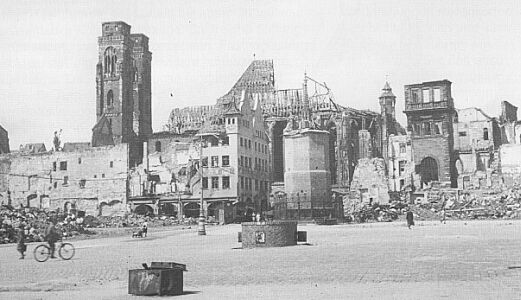 View of the ruins at the Hauptmarkt in Nuremberg, in 1945, with the walled-in "Schönen Brunnen" You are visitor no. |